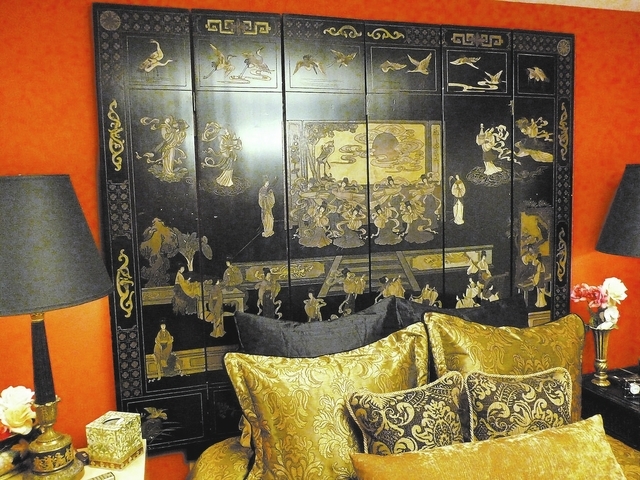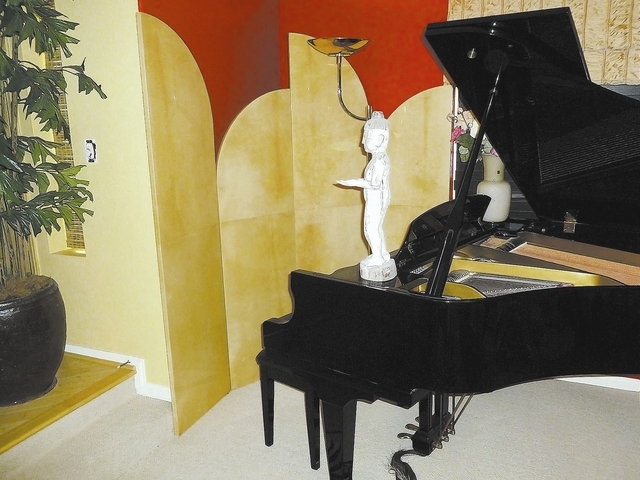Folding screens do more than separate spaces
I’d like to share one of the oldest tricks in the decorating book with you. It’s a secret weapon that can give a home a sense of atmosphere without going to heroic lengths. It’s not old fashioned and it’s never gone out of style and probably never will.
Actually it’s a type of free-standing furniture that’s an ancient invention that doesn’t even fit our traditional understanding of furniture. It might even be considered the most unusual object in the world of exotic furnishings. It’s the decorative screen. It is often used as a room divider, but it’s really so much more.
Obviously, I’m a huge fan of the folding screen, and yet I realize that it’s hard to explain its impact without actually experiencing one firsthand. The concept may even be somewhat intimidating because screens seem to be regarded as decorator territory.” That’s a shame because there are so many beautiful options available today and they’re not all cost prohibitive either. It’s truly a lost opportunity not to think about trying one in your home.
Now that city apartments seem to be growing ever more compact there’s great interest among designers in versatile screens that will allow an area to be manipulated in a way to fit a client’s requirements. Many people now live in contemporary homes with open living spaces where screens can be used as room dividers to separate a living, dining or bedroom space from the rest of a smaller, studio apartment, for example. They have the inherent ability to divide and define a living space while providing privacy and a bold decorative statement all at the same time. What other piece of furniture can lay claim to such capability?
Screens also can be placed around the edges of a room to change the whole shape and effect of a space and can be a wonderful solution when you’re faced with structural issues such as strangely angled corners. They also can be used to great success if there just isn’t enough space to put up an actual wall or when a rug or furniture arrangement just isn’t enough to visually separate a room.
Screens are there when you need something different, something more intriguing to get the job done. In a word, they provide an interesting way to divide up spaces without the use of solid walls thus allowing great versatility in the design of a room.
The history of the folding screen began in China in the seventh century and not in Japan as must of us familiar with Shoji screens might think. Their use eventually spread to east Asia, then to Europe around the time of Marco Polo and then on to other parts of the world. Probably the most famous and ubiquitous type of screen remains the ever-beautiful Coromandel that features carving on a clay surface that imparts a spectacular 3-D effect.
Currently, designers and manufacturers have added modern materials to create the latest version of the decorative room divider. Perforated materials, plastic and metals have allowed screens to take on a whole new vocabulary of shape, color and texture. Products are being developed that will resist graffiti and clean easily.
But no matter what the material, the decorative screen can and does wear many hats, whether pushed up against a wall for architectural interest and a splash of color or behind an upholstered headboard in a bedroom. (When used as an actual headboard, a look that I personally love, be sure to securely mount the screen to the wall.) They even look wonderful hung on a wall as a great piece of art and I’ve seen them used as cabinet doors for an entertainment unit or to bring life to some dark and uninteresting corner of a room.
A friend of mine actually used a screen to create an entry space or foyer in an apartment where there was none and now, in a new home, the same screen is being utilized as a glamorous headboard. Testament once again to the great versatility of this type of furniture piece.
Screens also can be used in place of closet doors or mounted on a sliding door mechanism. They can even be used to cover windows, just like curtains only with more flexibility, and can hide myriad necessary evils in a home such as an unfortunately placed powder room door, an unruly pile of toys or an undesirable view, all while adding great style, pattern and color.
When deciding on the best decorative screen for your space always consider what size screen will work to the best advantage as well as the theme of the room or the era being interpreted and how the screen will be used. You’ll also need to take into consideration whether you want a single-sided screen or a double-sided one where the pattern or texture can be viewed from both sides.
In a word, when a living space has to be divided into functional zones, nothing can accomplish this task better than the folding screen with its incredible versatility, mobility, adjustability and aesthetic value. They require no installation and they can be folded, moved and placed in another room anytime you like. It retains all of its versatility while looking absolutely beautiful and satisfying any style preference or decorating taste.
Stephen Leon is a licensed interior designer and president of Soleil Design; he has been designing and manufacturing custom furniture and cabinetry for more than 25 years. He is president-elect of the Central California/Nevada Chapter of the American Society of Interior Designers and is a certified professional in green residential design. Questions can be sent to soleildesign@cox.net.



















